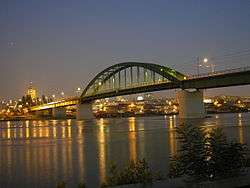Old Sava Bridge
Old Sava Bridge (Serbian: Stari savski most) is a 410-metre long bridge, crossing the river Sava in Belgrade, Serbia. It is the smallest road bridge in the Serbian capital and is used both for car and tram traffic. The main span between the two pillars of this tied arch bridge is over 100 m in length. Two bus lines and three tram lines of Belgrade public transport use the bridge.

History
The bridge was built in 1942, during the German occupation, because the only remaining bridge crossing the river Sava at that time was demolished. For that reason, the purpose of the bridge was the transportation between the two river banks. The construction of the bridge was planned to be installed over the Tisa river, but the demolition of the King Aleksandar bridge led to the installation of the construction over the pillars on the Sava river.[1]
Reconstructions
The bridge had a wooden driveway until 1964, when the planners suggested the reconstruction of the bridge to the mayor Branko Pešić. After a five-year reconstruction a new concrete panel was placed. During the decade of the Eighties the first trams crossed the bridge and the concrete panel was replaced with the steel one.[2]
The traffic on the bridge has always been minor to other bridges crossing the river, due to the bad access to the bridge on the Novi Beograd side. It was one of the main reasons why the vast reconstruction of the bridge did not start until 2007. The road traffic over the bridge was reestablished in 2008. The reconstruction included new traffic signals, poured asphalt, fences and decorative lighting. The capacity of the bridge was increased to 30,000 vehicles per day.[3]

Denomination
The name of the bridge could be translated into English as Old Sava Bridge. However, the bridge had several names such as German bridge, Tram bridge or Old Sava bridge. None of them were official names. This bridge was the only big European bridge that was not demolished during the German retreats. The man who saved the bridge from German detonations was Miladin Zarić, a teacher who approached the enemies on the second pillar of the bridge, unhooked the cables and prevented the demolition. In October 1944 the German Army started to leave Belgrade and on their way, they planned to mine the bridge. During the war, Miladin Zarić was living near the bridge. He was the only one who knew about the mining and thus decided to risk his life and save the only connection between Central Serbia and Srem.[4] A citizens association called Imamo plan (We have a plan) with the support of the Savski venac municipality is collecting signatures for the initiative of naming the bridge after the brave teacher who saved it.[5]
See also
References
Coordinates: 44°48′40″N 20°26′52″E / 44.8110°N 20.4478°E